Here’s a list of 20 items that may make your Great Lake Basin (GLB) island trip more comfortable and more fun (with information on why you should consider packing each item at the end of the blog post). Don’t miss Book Giveaway Challenge #1 sandwiched in between the what and the why!
The List
- Valid passport or Enhanced Driver’s License (if you plan to cross the U.S.-Canadian border)
- Cash (in addition to credit cards)
- Clothes for layering
- Comfortable footwear
- Sunglasses
- Brimmed hat
- Sunscreen
- Water bottle
- Insect repellent
- Over-the-counter/prescription drugs & any medical equipment/needs
- Cell phone
- Camera
- Binoculars
- Nature identification books
- Collection bag
- Daypack
- Supplies/equipment for your own special interests
- Bathing suit and beach towel (depending on time of year and island location)
- Bicycle (check if the island you plan to visit has rentals) and bike helmet
- Kayak/canoe (check if the island you plan to visit has rentals) and life vest
Book Giveaway Challenge #1: What’s missing?
To be eligible to win a free copy of my book, Great Lakes Island Escapes: Ferries and Bridges to Adventure, comment on this blog post with an item not on the list or mentioned in “The Whys” text below. The winning entry will be the one item judged as the item among all entries most helpful to also have along on an island trip. Comments must be posted by midnight, Friday, April 15th. The winner will be announced Monday, April 18th. Don’t be shy!
The Whys
Here are the reasons to pack each item on the list.
Valid passport or EDL
The very most essential item to bring along if your island travel plans include crossing the U.S. – Canadian border, so you will not be turned away when you get there, is a valid passport or Enhanced Driver’s License (EDL):
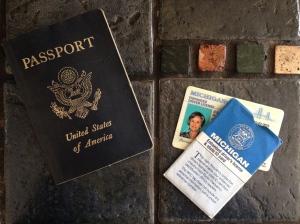
Cash
Most businesses on most islands will accept credit cards, but not all. Having some cash along for emergencies, as my dad might say, is always a good idea anyway.
Clothing for layering
A summer evening on an island’s coastline can be wonderfully breezy and cool, but comfortable only if you’re prepared for it. The Great Lakes and their rivers provide a more temperate climate. That means that in addition to being able to support vineyards, for example, it takes longer in the spring for the temperatures to warm up. Having casual, comfortable clothes that can be layered may make all the difference between having a great trip or not.
An easy way to pack island-exploring attire is to think in four layers:
- a sleeveless or short-sleeve cotton shirts in warmer months or a long-sleeve thermal shirt in the cooler months
- a long-sleeve button-up shirt that can be worn over the first layer or removed and stuffed in your daypack, cotton in the warmer months and flannel or wool in the cooler months
- a sweatshirt or fleece that can go over one or both of your first two layers

Barb and I experienced a range of temperatures biking the islands of the Long Sault Parkway of the St. Lawrence River in mid-September; “layering” helped us enjoy whatever weather we rode into, here, at the 45th parallel north.
- a windbreaker and/or rain poncho (or water-repellent/waterproof “shell” jacket). I found it helpful to have a very thin nylon windbreaker that could be stuffed into its own front pocket, becoming the size of my bird guide and weighing much less. I also carried a rain poncho in a pouch that could go over all of my other layers in a pinch, especially if a shower came up during a bike ride.
If you pack well, you’ll rarely be stuck indoors on an island (two exceptions would be a thunderstorm or a tornado watch/warning). While you may be able to buy a souvenir T-shirt or sweatshirt, depending on the island, don’t plan on being able to supplement your wardrobe once you’re there.
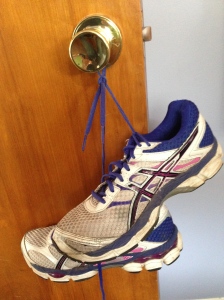
Earlier pairs of these Asics Gel-Cumulus walked 136 GLB islands.
Comfortable footwear
The beauty of many of the Great Lakes Basin islands is that they provide many opportunities for interesting walks, often including hikes through nature. A pair of comfortable walking shoes is a must. You may want to bring along hiking boots if you plan to take advantage of island trails, particularly those involving rocky terrain (e.g., Isle Royale or the northern half of Beausoleil Island).
I hiked quite a bit on my island trips and wore only a good-fitting, cushioned athletic shoe although a number of my companions wore hiking shoes or boots. If you plan to do serious bike riding, bring the shoes for it. If you’re going to be on an island featuring rocky beaches—the wonderful School House Beach on Washington Island comes to mind—bring water shoes.

School House Beach on Washington Island, Wisconsin in Lake Michigan
Sunglasses—Both on ferries and on islands, expect more glare than you might be exposed to at home, from the sun reflecting off the water.
Brimmed hat—A tight-fitting baseball hat or cycling cap will stay put best in island breezes and shade your face.
Sunscreen—Remember, because islands are surrounded by water the sun’s UV rays are increased via reflection. Protect your skin!
Water bottle—Even though islands are surrounded by water, you will find it easier to carry a water bottle (than a water filtration kit) if you’re hiking or biking.
Insect repellent

Vicki and I planned our trip to Isle Royale for the last week in August, in part to avoid the Black Fly Season there.
You may be pleasantly surprised to find that the island you’re visiting is not being visited by mosquitos or black flies because of the way the wind is blowing, or because it’s not “Black Fly Season,” or because of some other reason that only an islander will be able to explain, but you should not expect this. In 12 months of island research, I was very fortunate: the insects did not manage to find me, but if they had, I was prepared.
Over-the-counter or prescription drugs and other medical equipment/needs
Offhand, I can think of only a handful of islands, of the 136 I visited, that boasted a pharmacy. Many GLB islands have, if any stores at all, a small grocery store that does not host a pharmacy. Although you may be able to purchase sunscreen, insect repellent, and over-the-counter pain relievers on an island, you should not expect that this will be the case and certainly do not expect to find other pharmaceutical needs available. Antibiotic cream and Band-Aids may come in handy, too.
In some cases, islands have medical clinics staffed by a nurse. For most medical emergencies on most islands, a trip to a mainland hospital is how one receives treatment. If the access to the island is by ferry—depending on the length of the ride and the seriousness of the medical need—this may mean being medically evacuated off the island by helicopter, if the island has such a service available.
While such a situation is something no one plans to have happen on a trip, it may be helpful to think ahead and discuss any medical concerns with your own physician before planning an overnight trip to an island that does not have medical facilities.
Cell phone
A couple things about cell phones and GLB islands:
- You may find you have limited or no wireless service on the islands you visit. This means if you plan to do serious hiking, on Isle Royale, for example, you’ll need to also pack a compass. Consider, too, that should your cell phone go die, that great flashlight app you have will not be available. A pocket flashlight may be a good thing to have along.
- If you cross the international border, you may want to turn your phone off to avoid unwanted charges unless you have an international data plan, a SIM card to allow you to switch your service to the host country, or a prepaid cellphone. It is highly advisable to turn off your phone’s roaming capabilities. Check with your own service provider for more information on cell phone charges and usage available for your island destination.

Michigan artist Karen Klein pursues a dragonfly on Washington Island.
Camera
You may discover your cell phone camera takes better photos than any compact digital camera does, something worth checking out ahead of your trip. Of course, if you have nowhere to charge your cellphone, bringing along a camera as a back-up is a good plan.
Binoculars—A pair come in handy for identifying birds and ships (and whatever that is ahead on the trail!)
Nature identification books
For identifying whatever interesting finds you come across on your trip (whatever your pleasure, but possibilities include:)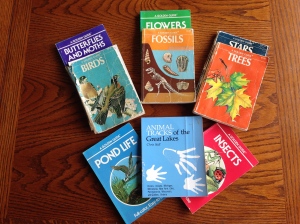
- Bird guide
- Wildflower guide
- Fossil guide
- Butterfly guide
- Tree guide

My daughters’ “Collector Bags” from childhood, made from parts of their worn-out jeans.
Collection bag—Perfect for beach glass, fossils, or stones (on islands where your finds are not protected by state, provincial or federal regulations); in a pinch, a plastic bag will do.
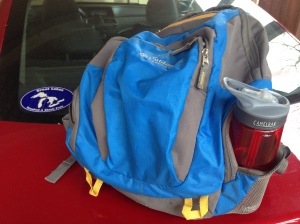 Daypack
Daypack
Even if you’re not camping or hiking, a daypack can come in handy, particularly for toting all of the items listed above. Island attire tends to lean toward casual outdoor wear, where, for women, a daypack comfortably replaces a purse. For men and women, alike, a daypack provides a great way to carry those extra layers of clothing when they’re not needed.
 Supplies and/or equipment related to your special interests
Supplies and/or equipment related to your special interests
This includes everything from fishing equipment to a flower press, golf clubs to writing or sketching supplies and then some. Even if you don’t consider yourself an “artist” or a “writer,” you may be surprised by what can happen when you’re on “island time.” Creating a sketch of an island scene or a written description of what you did on an island is a very fun way to preserve an island adventure. As a proponent of the latter, I’ll be offering a workshop, “The Travel Journal Adventure,” at some of the venues where I’m giving readings this summer.
Optional:
Bathing suit, beach towel, and beach paraphernalia
Don’t leave home without these if you are planning a trip during the summer months. Typically, only Lake Erie’s water temperature may allow for comfortable swimming in an extended season, reaching into late May and early September. July and August are generally the best swimming months in the other Great Lakes.

This is the bike before it traveled with me to many GLB islands.
Bicycle
A hybrid bike, typically offering the best of the road and comfort-style bikes, is perfect for island exploring. Many islands offer bike rentals if you are not equipped to transport your own bike, or if you don’t intend to spend more than a day of bike riding on the island.
Bike helmet – On most islands, you’ll be sharing the only roads there are with motor vehicles. (Something you needn’t worry about on Mackinac Island.)
Kayak/canoe – If you have one, you couldn’t ask for a better place than an island to bring a kayak or canoe along to. A number of islands offer kayak and/or canoe rentals. Don’t forget a life vest for each paddler.
And, of course, if you plan to camp on your island trip, you will have a complete sub-list of camping equipment and supplies. (Be sure to check that camping is allowed on the island and what type of campground is available before packing it all up.)
Remember . . .
Leave a comment including an item to add to this list in order to be entered in the book giveaway!


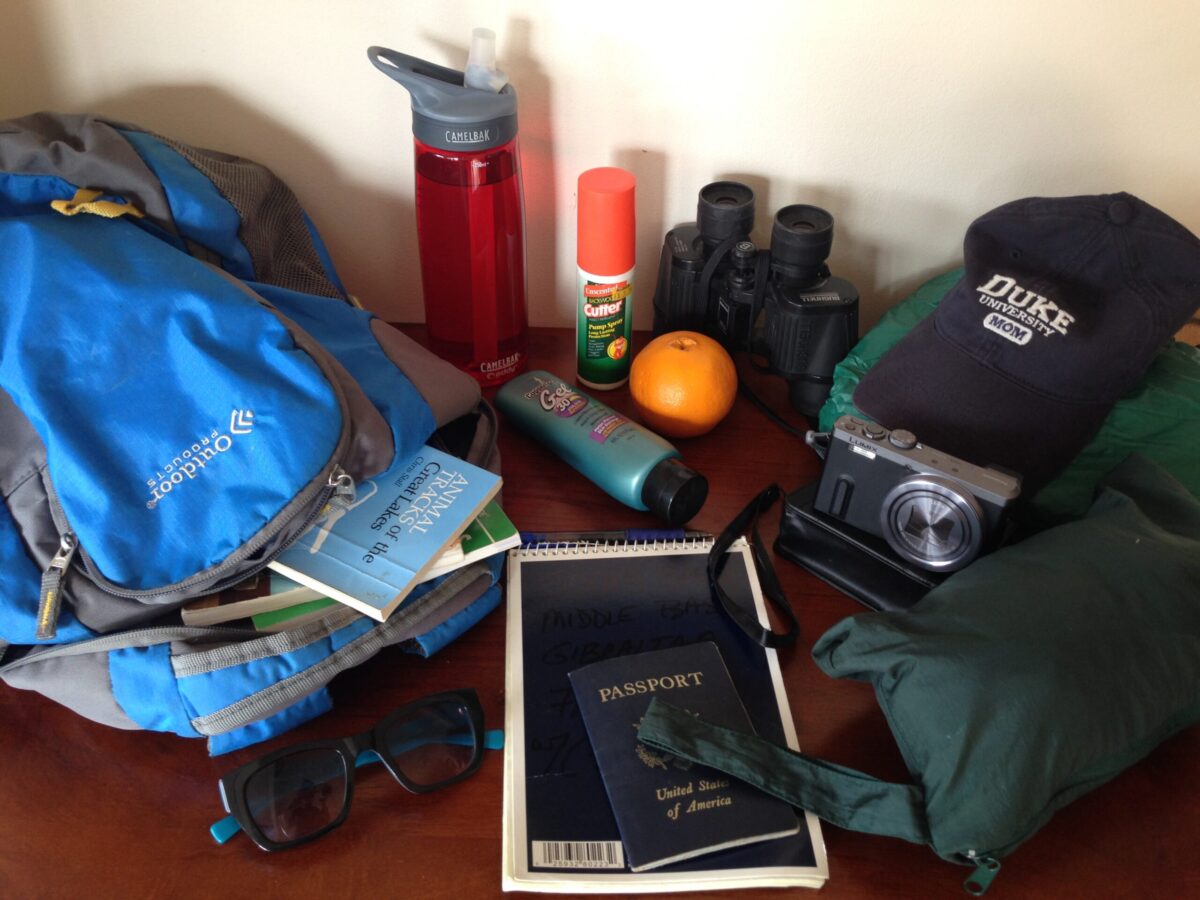






Hmm, methinks you have covered the list of what to bring, Maureen. But in the interest of winning a book, I will put on my thinking cap! lol
I’m interested in seeing what you come up with, Barb!
Please ensure you have a full tank of gas. Some folks arrive to our Island just not realizing, assuming they can fill up. Some farmers have a fuel supply but its officially illegal to sell it. We’ve gifted a few folks, bouncing on empty.
Great suggestion, Sally! Thank you!
Bandaids. Someone always gets some sort of injury or blister. A bit of duct tape may come in handy for various repairs, too. Just wrap some around a water bottle, don’t carry that whole big, heavy roll. While I am on this track, be sure to carry a paper copy of emergency contacts.
Great ideas, Andie! Bandaids I mentioned, but duct tape and emergency contacts–don’t leave home without them! Thanks!
You have to have a book to read in the evenings. Maybe you have them on your smart phone, maybe not. Even when backpacking I have a book.
You’re a woman after my own heart, of course. Your book, “North Country Cache: Adventures on a National Scenic Trail,” accompanied me to an island or two, Joan!
Definitely a smile! How can you be on our wonderful islands without one!
And, certainly if one doesn’t arrive on the island with a smile, spending time with folks like you, Debbie, at places like your B&B “On Pelee Time” should work its magic!
Some trail mix, or some sort of easy nourishment. Or pack a lunch and sit and enjoy nature while eating it.
Thanks, Jeanne! I could use some trail mix right about now . . .
Wow, the additional suggestions are great! Gas in your tank, a book, trail mix, contact info — it took someone with experience in island living or island travel to think of those few you missed, Maureen. Good job ladies! 🙂
Barb, you have the greatest ability to make me and others smile:) Thank You!
A must is a journal – Blank pages to write the wonder you experience during your visit, or to draw the new visions. It comes in handy to write down the answers that become crystal clear once you are in the woods.
Thanks, Diane, certainly true for me!
TP
On a few GLB islands, Aaron, that might not be a bad idea! Although even on North Manitou Island–the only island I visited where the trip is requires a visitor to camp–despite the recommendation to bring our own, the outhouse had toilet paper. Perhaps the generosity of another camper.